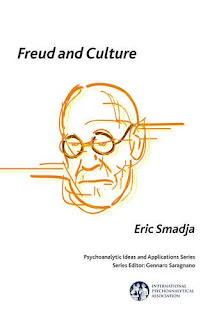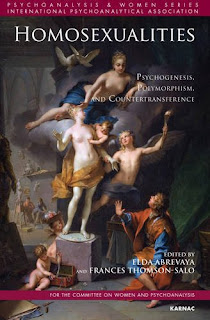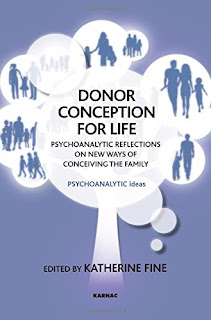If you’re a publisher or author, please let us know about your upcoming books by emailing freud.quotes [at] gmail [dot] com so you may be included in future roundup.
#51 The Hidden Freud: His Hassidic Roots by Joseph H. Berke
The author shows, for example, how Freud utilized the Jewish mystical tradition to develop a science of subjectivity. This involved the systematic exploration of human experience, uncovering the secret compartments and deepest levels of the mind (such as the preconscious and unconscious methods of thinking), expanding human consciousness beyond 'objective' reality, and the revelation of hidden, unconscious thought processes by free association and dream analysis (all linked to kabbalistic modalities such as 'skipping and jumping'). The book also explores the close connections between psychoanalysis, quantum physics, and Kabbalah.
Book preview: The Hidden Freud: His Hassidic Roots
#52 The Vicissitudes of Totemism: One Hundred Years After Totem and Taboo by Gerard Lucas
After being the subject of many studies up until 1914, totemism seemed to disappear from the literature. The publication of Freud's work Totem and Taboo was initially greeted with silence, and subsequently with critical and hostile reactions. C. Lévi-Strauss was one of the few to devote a book to totemism but considered it as an illusion, although a number of prominent members of the English school of Social Anthropology contested this view, describing the direction adumbrated by Freud's enquiry as 'highly pertinent'.
#53 Freud and Culture by Eric Smadja
In this book Eric Smadja explores the representations of society and culture that Freud developed in the course of his work. Distinct from contemporary sociological and anthropological conceptions, they led to his construction of a personal socio-anthropology that was virulently criticised by the social sciences. But what exactly is meant here by 'culture' and 'society'? Do we mean Freud's own Viennese society or Western, 'civilised' society in general?
Book preview: Freud and Culture
#54 The Freudian Orient: Early Psychoanalysis, Anti-Semitic Challenge, and the Vicissitudes of Orientalist Discourse by Frank F. Scherer
This study consists of a twofold, interrelated enquiry: the Orientalism of psychoanalysis and the psychoanalysis of Orientalism – bringing into conversation Sigmund Freud and Edward Said and, thereby, the founding texts of psychoanalysis and postcolonial studies. The immediate object of this exploration is the “Freudian Orient” and we thus begin by tracing the strong Orientalist presence in Freud’s writings with examples from his early as well as later correspondence, his diaries, and his psychological works.
Book preview: The Freudian Orient: Early Psychoanalysis, Anti-Semitic Challenge, and the Vicissitudes of Orientalist Discourse
#55 Freud and the Dora Case: A Promise Betrayed by Cesare Romano
Dora's analysis is investigated alongside what was happening in Freud's life at the time of the therapy. It was a time of upheaval, including the breaking off of his friendship and transferential relationship with Fliess, and the erotically nuanced relationship with his sister-in-law Minna. Romano demonstrates how these real-life events and the experiences they entailed reflect on Dora's therapy, modulating Freud's countertransference.
Book preview: Freud and the Dora Case: A Promise Betrayed
#56 Murdered Father, Dead Father: Revisiting the Oedipus Complex by Rosine Jozef Perelberg
The distinction between the murdered (narcissistic) father and the dead father is seen as providing a paradigm for the understanding of different types of psychopathologies, as well as works of literature, anthropology and historical events. New concepts are introduced, such as "a father is being beaten", and a distinction between the descriptive après coup and the dynamic après coup that provides a model for a psychoanalytic understanding of temporality. The book includes a reflection on how the concepts of the death instinct and the negative, in their connection with that which is at the limits of representability, are an aid to an understanding of Auschwitz, a moment of rupture in European culture that the author characterizes as " the murder of the dead father".
#57 The Subject of Torture: Psychoanalysis and Biopolitics in Television and Film by Hilary Neroni
Considering representations of torture in such television series as 24, Alias, and Homeland; the documentaries Taxi to the Dark Side (2007), Ghosts of Abu Ghraib (2007), and Standard Operating Procedure (2008); and "torture porn" feature films from the Saw and Hostel series, Hilary Neroni unites aesthetic and theoretical analysis to provide a unique portal into theorizing biopower and its relation to the desiring subject. Her work ultimately showcases film and television studies' singular ability to expose and potentially disable the fantasies that sustain torture and the regimes that deploy it.
#58 Respect, Plurality, and Prejudice: A Psychoanalytical and Philosophical Enquiry into the Dynamics of Social Exclusion and Discrimination by Lene Auestad
The author makes a case for framing a questioning of prejudice, not in terms of normality versus pathology or deviance, but in what is socially unconscious. Hypocrisy and double standards are inherent in our social practices, reflecting the contradictions present in our thinking about these issues: that we both believe and do not believe in equality. Thus this study takes account of conflicts between theory and practice, layers of implicit- and explicitness, pre- and unconscious experience and the power differentials that shape these constellations.
#59 Structure and Spontaneity in Clinical Prose: A Writer's Guide for Psychoanalysts and Psychotherapists by Suzi Naiburg
Structure and Spontaneity in Clinical Prose will teach you to read gifted writers for inspiration and practical lessons in the craft of writing; apply the principles and techniques of the paradigmatic, narrative, lyric narrative, evocative, and enactive modes of clinical prose; and put what you learn immediately into practice in eighty-four writing exercises.
Book preview: Structure and Spontaneity in Clinical Prose: A Writer's Guide for Psychoanalysts and Psychotherapists
#60 Somatic Experience in Psychoanalysis and Psychotherapy: In the expressive language of the living by William Cornell
The body, of both the patient and the analyst, is increasingly a focus of attention in contemporary psychoanalytic theory and practice, especially from a relational perspective. There is a renewed regard for the understanding of embodied experience and sexuality as essential to human vitality. However, most of the existing literature has been written by analysts with no formal training in body-centered work. In this book William Cornell draws on his experience as a body-centered psychotherapist to offer an informed blend of the two traditions, to allow psychoanalysts a deep understanding, in psychoanalytic language, of how to work with the body as an ally.
Book preview: Somatic Experience in Psychoanalysis and Psychotherapy: In the expressive language of the living
# 61 Working With Difficult Patients: From Neurosis to Psychosis by Franco De Masi
In this book the author examines the series of connections that give rise to the intimate relationship between environment and individual in the construction of emotional suffering, emphasising both the undisputed pathogenic action of environmental stimuli and the active participation of whoever is obliged to suffer the negative situation. Franco De Masi shows that the way in which one tries to escape suffering is what often seriously jeopardises growth.
#62 Creativity and Psychotic States in Exceptional People: The Work of Murray Jackson, edited by Jeanne Magagna
Jackson and Magagna aim to illustrate how psychoanalytic thinking can be relevant to people suffering from psychotic states of mind and provide understanding of the personalities of four exceptionally talented creative individuals. Present in the text are themes of loving and losing, mourning and manic states, creating as a process of repairing a sense of internal damage and the use of creativity to understand or run away from oneself. The book concludes with a glossary of useful psychoanalytic concepts.
#63 Psychoanalysis and the Artistic Endeavor: Conversations with Literary and Visual Artists by Lois Oppenheim
Psychoanalysis and the Artistic Endeavor offers an intriguing window onto the creative thinking of several well-known and highly creative individuals. Internationally renowned writers, painters, choreographers, and others converse with the author about their work and how it has been informed by their life experience. Creative process frames the discussions, but the topics explored are wide-ranging and the interrelation of the personal and professional development of these artists is what comes to the fore. The conversations are unique in providing insight not only into the art at hand and into the perspective of each artist on his or her own work, but into the mind from which the work springs.
Book preview: Psychoanalysis and the Artistic Endeavor: Conversations with Literary and Visual Artists
#64 Psychoanalytic Studies of Creativity, Greed and Fine Art: Making Contact with the Self by David P. Levine
Using examples primarily from visual art David Levine explores the subjects of creativity, empathy, interpretation and thinking through a series of case studies of artists, including Robert Irwin, Ad Reinhardt, Susan Burnstine, and Mark Rothko. Psychoanalytic Studies of Creativity, Greed and Fine Art explores the highly ambivalent attitude of artists toward making their presence known, an ambivalence that is evident in their hostility toward interpretation as a way of knowing. This is discussed with special reference to Susan Sontag’s essay on the subject of interpretation.
Book preview: Psychoanalytic Studies of Creativity, Greed and Fine Art: Making Contact with the Self
#65 A Casebook of Psychotherapy Practice with Challenging Patients: A Modern Kleinian Approach by Robert Waska
Most contemporary psychoanalysts and psychotherapists see each patient once or twice a week at most. As many patients have reached a marked state of distress before seeking treatment, this gives the analyst a difficult task to accomplish in what is a limited amount of time. A Casebook of Psychotherapy Practice with Challenging Patients: A modern Kleinian approach sets out a model for working with quite significantly disturbed, distressed, or resistant patients in a very limited time, which Robert Waska has termed "Modern Kleinian Therapy."
Book preview: A Casebook of Psychotherapy Practice with Challenging Patients: A Modern Kleinian Approach
#66 The Shadow of the Second Mother: Nurses and Nannies in Theories of Infant Development by Prophecy Coles
The author explores the lives of several well-known people who have been wet nursed, such as Michelangelo, Rousseau, Jack London, Nabokov and Klein. She speculates that they all were affected emotionally by their ‘second mother’, and concludes that a universal feature of such delegated mothering seems to be that the bond between mother and child is broken, and the child may be left with a life-long distrust of close relationships. In The Shadow of the "Second Mother", Coles combines an exploration of attachment theory with neurology, making it possible to give an explanation as to why these important figures have lain unnamed and ignored in our social and psychological consciousness.
#67 The Psychomatrix: A Deeper Understanding of Our Relationship with Pain by Doreen M. Francis
What is pain? What does it mean to have a relationship with it and how does this affect your identity and existence? Doreen Francis' definition of pain is derived from that proposed by scientists, such as Melzack, Wall and Freud. Pain is a dynamic, multi-layered, diverse collection of experiences, which impacts and influences us throughout life. Pain is a kind of conglomerate of past, traumatic, neurobiological, psychological and emotional imprints - pain as in suffering or being in pain. The author's aim here is to argue that it is not pain, as such, but our relationship with pain, which is most significant to the processes of our lives.
#68 Homosexualities: Psychogenesis, Polymorphism, and Countertransference, Edited by Elda Abrevaya and Frances Thomson-Salo
This latest volume in the Psychoanalysis and Women Series for the Committee on Women and Psychoanalysis of the International Psychoanalytical Association presents and discusses theoretical and clinical work from a number of authors worldwide. It clearly demonstrates that there is no typical development of homosexuality and that each individual’s object-choice can only be grasped by examining their psychic history. While the therapeutic work requires no special adaptation of technique, countertransferential difficulties which may arise and stem in part from cultural representations about gender differences are fully explored. The book includes a unique retrospective view by Ralph Roughton over three time points which charts changes in considering the analyst’s response within the wider cultural context.
#69 Formless Infinity: Clinical Explorations of Matte Blanco and Bion by Riccardo Lombardi
In contemporary psychoanalysis, a key concept and aim of clinical practice is to distinguish the boundaries of any mental state. Without this boundary-setting, the patient has nothing but the 'formless infinite' of primitive mental states. Formless Infinity: Clinical Explorations of Matte Blanco and Bion draws on the work of these two authors to explore how analysts can work with patients to reveal, understand and ultimately contain their primitive mental states.
#70 Playing and Reality Revisited: A New Look at Winnicott's Classic Work, Edited by Gennaro Saragnano and Christian Seulin
Playing and Reality Revisited is the first volume of a new IPA series dedicated to the greatest writings of psychoanalysis. More than forty years after its publication, Donald W. Winnicott's Playing and Reality is still a source of inspiration for numerous psychoanalysts. Gennaro Saragnano and Christian Seulin have invited some of the most eminent specialists of Winnicott's thinking to write on the most significant themes that the author discovered and highlighted brillantly in his book. They show how such concepts as transitional object and phenomena, the use of an object, and mirroring, remain essential today, and explore the way in which Winnicott conceived playing, creativity, cultural experience and adolescence, demonstrating their contemporary relevance. This book is both an homage to Winnicott and a fascinating extension of his work
#71 Donor Conception for Life: Psychoanalytic Reflections on New Ways of Conceiving the Family, Edited by Katherine Fine
This book is about the psychological experiences of women and men who have used donor conception to create their families. The authors offer diverse accounts of their clinical, research, and personal experiences. They describe the challenge of powerful conscious and unconscious fantasies that can be aroused and how these may reawaken early anxieties and developmental struggles.
Book preview: Donor Conception for Life: Psychoanalytic Reflections on New Ways of Conceiving the Family
#72 Premature Birth: The Baby, the Doctor and the Psychoanalyst by Catherine Vanier
If advances in medical technology now allow babies to be born earlier and survive premature birth, what of the psychical impact of this emergence into the world? What consequences can premature birth have for babies, for their families, and for the medical staff around them?
#73 Lacanian Coordinates: From the Logic of the Signifier to the Paradoxes of Guilt and Desire by Bogdan Wolf
This book explores the points of Lacanian orientation that lead us to the particularity of the subject, and considers whether we find them not solely in the discourse of the universal, to which religion, science and philosophy testify, but also in the analytic experience itself. Psychoanalysis creates conditions for an encounter with an analyst and with words forgotten, neglected, underestimated, yet also bursting with meaning and surprises. Each chapter contributes to this subjective realisation, taking as reference the clinic, the voice of an analysand, and everyday discourse. An ethics that emerges from this experience is not of the superego but of a speaking being faced with the non-existence of an all-knowing and all-powerful Other.
Book preview: Lacanian Coordinates: From the Logic of the Signifier to the Paradoxes of Guilt and Desire
#74 Pink Herrings: Fantasy, Object Choice, and Sexuation by Damien W. Riggs
Pink Herrings engages in a re-examination of six of Freud's cases via Lacan's account of sexuation. Specifically, the book outlines a theoretical framework in which sexuation is understood as a 'choice' made in response to the fact of the sexual non relationship. In making this choice, unconscious fantasy allows for the circulation of object a, which bear traces of jouissance. Drawing upon Lacan's distinction between phallic and other jouissance, Pink Herrings examines the four positions outlined in Lacan's formula of sexuation, and maps these onto the six case studies. In so doing, Pink Herrings not only brings new life and insights to the cases, but also clears a path to what is referred to as a 'clinic of sexuation'. Such a clinic would not replace existing Lacanian psychoanalytic practice (with its focus on the structures of neurosis, perversion and psychosis), but instead provide additional avenues through which to explore the operations of fantasy.
Book preview: Pink Herrings: Fantasy, Object Choice, and Sexuation
#75 Freud's Legacy in the Global Era by Carlo Strenger
Freud’s Legacy in the Global Era presents a radically new perspective on Freud’s relevance today as a forerunner of the contemporary evolutionary neurosciences also steeped in the tradition of humanistic thought. Carlo Strenger shows how globalisation has produced new theoretical, practical and clinical issues for psychoanalysis, which can best be understood by drawing on influences from economics, sociology and philosophy.
Book preview: Freud's Legacy in the Global Era
Stay tuned for the Part IV!
If you’re a publisher or author, please let us know about your upcoming books by emailing freud.quotes [at] gmail [dot] com so you may be included in future roundup.



























